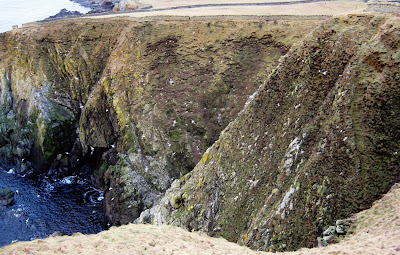









Looking North West towards Fitful Head.




The old foghorn is still present.


The lighthouse - from the south side.

The Sumburgh Lighthouse was designed by Robert Stevenson. On Mr Stevenson's inspection voyage of August 1815, he stated that Sumburgh Head was an eligible situation for a lighthouse and he will survey the rock and report as to the proper site for a lighthouse.
The building work started in January 1819 with Mr John Reid of Peterhead as the building Contractor. Sumburgh had walls of double thickness to keep out the damp, it also had 26 reflectors instead of the normal 21 and in 1822 the annual cost of maintaining this station was £650.00.
The most serious offence a lightkeeper could commit was falling asleep on watch, as this might allow the light to be extinguished, impair its efficiency, or even alter its character by letting the revolving machinery run down. There was fifteen cases of this kind in the second half of the 19th Century, the worst was a conspiracy at Sumburgh Head in 1871 by which two lightkeepers agreed not to report the other for sleeping at his post; one of them was a Principal lightkeeper with 23 years service - both were dismissed.
The optical apparatus is group flashing with Stevenson's equiangular refractor showing flashes every 30 seconds. The contractors were Chance Brothers & Co Ltd of Birmingham and also James Dove & Co of Greenside, Edinburgh.

http://www.nlb.org.uk/ourlights/history/sumburgh.htm

The steps up to the base of the light & also now the steps to the Sumburgh RSPB office.



A trip up to Compass Head - looking north towards Sumburgh Airport

While there we noticed a helicopter landing at the Sumburgh Hotel (the red dot)...

a private helicopter landing at the hotel


the Sumburgh Hotel










.jpg)



No comments:
Post a Comment
Leave your comments here, all comments are moderated before publishing.